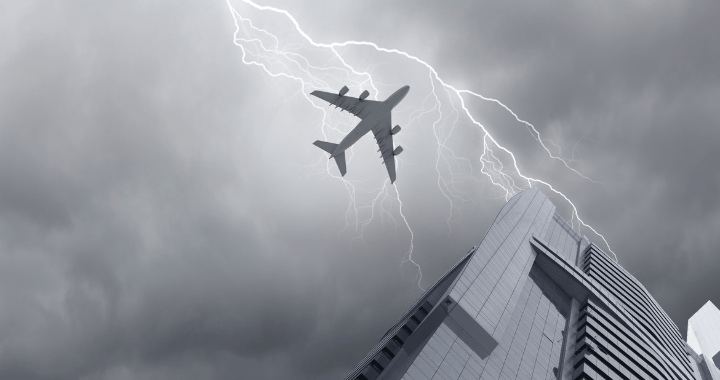The weather is one of the most unpredictable elements that pilots must contend with. Likewise, one of the major concerns for many travelers is whether their flights may encounter thunderstorms. Thunderstorms pose an immense challenge for pilots due to their volatile nature. With powerful updrafts and downdrafts that can top 100 miles per hour, thunderstorms make for some of the most hazardous weather conditions faced by pilots.
Today’s post is dedicated to exploring the questions around whether planes can actually fly in thunderstorms or if these dangerous storms pose too great a risk.
Flying through a thunderstorm presents very real dangers that test a pilot’s skill. Thunderstorms bring strong winds, heavy rain, hail, lightning, and severe turbulence–all of which threaten an aircraft’s control and safety. Given their unpredictability and ability to rapidly change direction, entering a thunderstorm could inadvertently put a plane in extreme danger. For these reasons, most aviation experts would agree that flying directly into a thunderstorm should always be avoided if possible.
However, with constantly changing weather patterns, how do pilots and air traffic controllers determine if flying is too hazardous? Let’s explore the factors that influence whether or not planes can fly in thunderstorm conditions!

Can Planes Fly In Thunderstorms?
The short answer to whether planes can fly in thunderstorms is: it is not recommended and pilots will aim to avoid doing so whenever possible. While aircraft are designed to withstand heavy rain, wind, and other adverse weather conditions, flying during a storm presents very real dangers that pilots aim to avoid. Thunderstorms with strong winds, heavy rain, hail, lightning, and extreme turbulence pose a serious hazard for aircraft. Still, it is possible to fly in thunderstorms.
It’s certainly not recommended for planes to fly in thunderstorms due to the risk of being struck by lightning or encountering wind speed and turbulence that threaten aircraft control. Lightning poses a particular threat as strikes can potentially disable vital aircraft electronics or damage the airframe. While modern aircraft are constructed of composite and conductive materials designed to route electricity from a strike safely around the plane, the potential for a catastrophic accident remains if pilots encounter storms.
Air traffic control monitors weather radar systems that alert pilots to incoming storms. If thunderstorms are near the flight path, pilots will likely cancel or reroute the flight to avoid flying into adverse weather conditions. However, once airborne, dynamic storms can sometimes force rerouting as well.
Strong winds also buffet aircraft and make maintaining control difficult. Increased wind shear poses an additional flying challenge during storms. Pilots are trained to never fly into the most extreme areas surrounding storms indicated on radar with their cores of strong updrafts and downdrafts.
As mentioned in a post on how many pilots fly a plane, having more than one pilot is especially important when facing adverse weather conditions. Most flights get canceled due to bad weather or rerouted by air traffic control if thunderstorms pose a hazard to the anticipated flight path.

Problems with Flying in Thunderstorms
Severe Turbulence
Thunderstorms contain violent updrafts and downdrafts that can exceed 100 knots. This causes extreme turbulence that subjects the aircraft to shaking motions that threaten structural integrity and passenger safety. The intense oscillations make aircraft control difficult and flying stressful. Not to mention, passengers would find the rough ride frightening.
Lightning Strikes
Lightning is always a risk as thunderstorms contain active electrical charges. A strike could potentially damage key aircraft systems through induced currents or a direct hit. Critical avionics, instruments, and electronics are vulnerable to lightning-caused malfunctions. While planes have protective measures, the possibility of a strike leading to catastrophic failure means avoiding storms is safer.
Issues During Takeoff and Landing
Strong winds near thunderstorms alter rapidly due to outflow boundaries. This can affect an aircraft’s ability to safely take off or land due to wind shear surprises. Gusty crosswinds also make visual maneuvers hazardous. Go-arounds may be needed if storms blow in, tiring pilots and testing their skills and aircraft in high-stress situations.
Hail and Heavy Precipitation
Hail poses a dual risk as pea to golf ball-sized chunks can dent external composites or penetrate engines on impact. Torrential rain also reduces visibility, complicating landing and takeoff. Onboard radar may be bounced off the storm, degrading guidance. Intense downpours stress airframes through changing altitudes.

How Do Thunderstorms Affect Flights?
Flight Delays
When thunderstorms are near airports, air traffic controllers may implement ground stops that prohibit takeoffs and landings until storms pass. This prevents planes from flying into potentially hazardous weather. Ground stops can cause delays that range from 30 minutes to over an hour depending on the storm’s severity and movement. Carriers must then work to regain schedules affected by these weather-related delays.
Flight Diversions
If thunderstorms develop along a flight’s planned route, pilots may be forced to divert to an alternative airport safely clear of storms. Air traffic control evaluates weather radar imagery and forecasts to suggest suitable diversion airports. Diverting adds flight time and fuel costs. Factors like passenger safety, efficient routing, and maximum fuel onboard influence the diversion decision-making process.
Flight Cancellations
For storms with high chances of lingering for extended periods, some flights may be preemptively canceled by carriers to best accommodate affected passengers. Cancellations allow time to rebook travelers and reposition aircraft and crews out of inclement weather. Repeated cancellations can occur if forecasters underestimate a storm system’s resilience and regeneration.
Impacts on Passengers.
The uncertainty from extreme weather delays and cancellations stresses passengers who face longer journeys or disrupted travel plans. Carriers provide lodging, meals, or refunds/rebooking for canceled flights depending on regulations. Communication is key to keeping customers informed of rapidly changing conditions overhead. Overall, safety always guides decision-making over schedule reliability when thunderstorms loom.
Is It Safe To Fly In A Thunderstorm?
The short answer is: that it can be safe for modern aircraft to fly in a thunderstorm depending on the storm’s severity. Today’s commercial jets are built to be very sturdy and resilient. Their fuselages, wings, and other components undergo rigorous testing to ensure they can handle high stresses caused by thunderstorm turbulence without sustaining any damage. Advanced materials also make aircraft structures lightweight yet extremely durable. Factors like wind shear and hail are not as big a concern for aircraft as they may seem.
Pilots flying jets are equipped with sophisticated instruments and avionics to help them monitor weather patterns from far away and navigate adverse conditions. Radars, satellite imagery, and other systems provide visibility even in total zero visibility. Automated flight control technologies also assist pilots in dampening the effects of turbulence and maintaining stability. This takes a lot of stress away from manually flying the plane during a storm.
Extensive training equips pilots with strategies to fly through thunderstorms carefully. They learn techniques to circumnavigate the most intense updrafts and downdrafts while also avoiding hailstorm regions. Pilots practice handling simulated thunderstorm scenarios in advanced flight simulators before ever taking off for real. They know how to assess risks and make continual decisions based on the latest weather forecasts.
Provided pilots follow strict safety protocols and use their training judiciously, modern jetliners can generally fly through thunderstorms without putting passengers at huge risk.
Thunderstorms should be avoided but when they can’t, you’re in safe hands.
While thunderstorms were once considered perilous for aircraft to fly through, modern jetliners have the capability to navigate such turbulent weather in a safe manner. While passengers may experience some turbulence, the risks of damage to the aircraft or injuries are substantially reduced compared to older aircraft and procedures from the past. This is a testament to the continuous efforts across the industry to ensure air travel remains safe, even in challenging weather that was once deemed too dangerous.
For more answers to questions related to your private jet ownership, consult our blog. And, if you’re looking for an easy and convenient tool that will help you and your crew avoid flight fatigue, thunderstorms, or not, we recommend exploring our fleet of JetBeds to find the one that best fits your aircraft!

